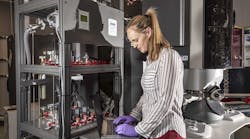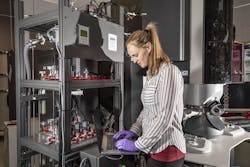All steel pipes rust and eventually fail. So, to preempt disasters, oil companies and others use computer models to predict when replacements are needed. But if the models go wrong, they can be modified only through experience, a costly problem if detection comes too late.
Now, researchers at Sandia National Laboratories have discovered that a particular form of nanoscale corrosion is largely responsible for unpredictably decreasing the working life of steel pipes. The research team used transmission electron microscopes, which shoot electrons through targets to take pictures. The images let the researchers pin the corrosion problem on a triple junction formed by a grain of cementite (a compound of carbon and iron) and two grains of ferrite (a type of iron). This junction commonly forms during most methods of fashioning steel pipe.
The researchers found that interfacial disorder in the atomic structure of those triple junctions made it easier for corrosive liquids to remove iron atoms along that interface.
In an experiment, corrosion stopped when the triple junction had been consumed by corrosion, but the crevice left behind let the corrosive liquid attack the steel’s interior.
“We thought of changing the microstructure of the steel surface during forging, but it still needs to be tested and have a patent filed if it works,” says Sandia’s principle investigator Katherine Jungjohann, a paper author and lead microscopist. “But now we think we know where the major problem is.”
Sandia National Laboratories researcher Katherine Jungjohann was the principal investigator and lead microscopist for a study that pinpointed a major cause of corrosion in pipelines. Here she looks for corrosion with a new transmission electron microscope at the Sandia national Lab. The gas valves on the shelves at left produce different testing environments. (Courtesy: Randy Montoya)
“This was the world’s first real-time observation of nanoscale corrosion in a real-world material, carbon steel, which is the most prevalent type of steel used in infrastructure worldwide,” added Aramco senior research scientist Steven Hayden. “Through it, we identified the types of interfaces and mechanisms that play roles in initiating and growing localized steel corrosion. The work is already being translated into models used to prevent corrosion-related catastrophes such as infrastructure collapse and pipeline breaks.”
To mimic the chemical exposure of pipe in the field, where the expensive, delicate microscopes could not be moved, thin pipe samples were exposed at Sandia to a variety of chemicals known to pass through oil pipelines.
Sandia researcher Khalid Hattar put a dry sample in a vacuum and used a transmission electron microscope to create maps of the steel grain types and their orientation, much as a pilot in a plane might use a camera to create area maps of farmland and roads, except that Hattar’s maps had approximately 6 nanometers resolution. (A nanometer is one-billionth of a meter.)
“By comparing these maps before and after the liquid corrosion experiments, the first phase that fell out of the samples could be identified, essentially identifying the weakest link in the internal microstructure,” Hattar says.
A Sandia National Laboratory transmission electron microscope helped create this phase equilibrium map showing areas in which corrosion of steel was observed at the triple junction formed by one cementite grain abutting two ferrite grains. (Courtesy: Katherine Jungjohann)
“The sample we analyzed was considered a low-carbon steel, but it has relatively high-carbon inclusions of cementite which are the sites of localized corrosion attacks,” notes Sandia researcher Paul Kotula.
“Our transmission electron microscopes were a key piece of this work, letting us image the sample, observe the corrosion process, and do microanalysis before and after corrosion occurred to identify the part played by the ferrite and cementite grains and the corrosion product.”
When Hayden first started working in corrosion research, he said, “I was daunted at how complex and poorly understood corrosion is. This is largely because realistic experiments involved observing complex materials such as steel in liquid environments and with nanoscale resolution, and the technology to accomplish such a feat had only recently been developed and yet to be applied to corrosion. We are optimistic that further work at Sandia will let us rethink manufacturing processes to minimize nanostructures that render the steel vulnerable to decay.”



